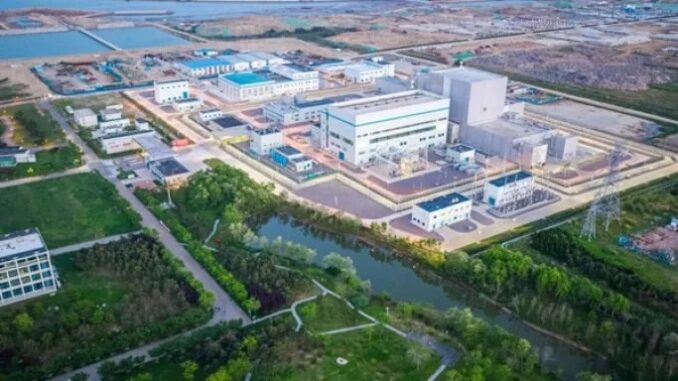
Published 2021/12/31
Photo: Shidaowan Nuclear Power Plant (NPP) in Shandong province of east China – high-temperature gas-cooled reactor nuclear power plant demonstration project
The state-run China National Nuclear Corporation (CNNC) announced on December 20, 2021 that at the Shidaowan Nuclear Power Plant (NPP) in Shandong province of east China, the world’s first High Temperature gas cooled Reactor of Pebble bed Module (HTR-PM) is now connected to the grid.
It is the first fourth generation (GEN IV) NPP of High Temperature Gas cooled Reactor (HTGR) connected to the grid, along with its unique inherent safety and robust reliability.
China is one of the few countries that has been capable of mastering the GEN IV technology, the first to make use of ‘pebble bed reactor’ (PBR) technology, making it a leader in global nuclear power technology advancement.
A key reason for developing the HTR-PR is its inherently safe design. Pebble bed reactor (PBR) technology is safe – the reactor cannot melt down. While today’s reactors are safe due to multiple, redundant, engineered shutdown, cooling, and containment systems, the PBR is safe because the basic physics increases neutron absorption if the temperature rises.
The majority of the equipment in current large water-cooled reactors is redundant safety systems which adds enormously to cost as well as regulatory complexity. With a simplified safety case and volume production, costs are projected to halve, making this design competitive with modern coal-fired plants. Levelized costs of electricity of less than 6.5¢/kWh have been projected.
One of the most practical and effective solution to resolve the challenge of China’s Carbon Dioxide Peaking and Carbon Neutrality goals, CNNC has confidence to implement more HTGR projects for its comprehensive application for power generation, process heat supply, district heating, seawater desalination and etc. CNNC will further strengthen its partnership with Tsinghua University for revolutionary and practical innovation to accelerate the massive deployment of the HTGR technology, while establishing an advanced nuclear industry.
One issue the project is squarely aimed at assessing is the feasibility of developing a cost-effective solution that will virtually eliminate air pollution and CO2 production from selected units of China’s existing installed base of modern 600 MW supercritical coal-fired power plants. Converting coal-burning supercritical steam plants to nuclear power plants by replacing the coal furnaces and boilers with high temperature gas cooled reactors holds considerable promise to become a routine power plant improvement in the relatively near future.
微信图片_20210915154639_副本.jpgShidaowan Nuclear Power Plant (NPP) in Shandong province of east China – high-temperature gas-cooled reactor nuclear power plant demonstration project
The first unit of the Shidaowan reactor project, built near the city of Rongcheng in collaboration with the energy group Huaneng and Beijing’s Tsinghua University, was connected to the grid, CNNC said on Monday.
The unit has total generation capacity of around 200 megawatts, and a second unit is still under construction.
In PBR technology, the reactor core is formed from graphite pebbles that contain specially designed fuel particles. The design allows reactors to be run safely at higher temperatures, CNNC said, describing it as “the reactor that won’t melt down”.
China is one of the few countries in the world with an active nuclear reactor programme, but it has struggled to meet its construction targets after a moratorium on new projects and a long safety probe following Japan’s Fukushima disaster in 2011.
Total capacity hit 51 gigawatts (GW) by the end of last year, falling short of a 58 GW target. CNNC has urged the government to approve at least six new projects a year over the next decade in order to bring total capacity up to 180 GW by 2035. read more
CNNC said the technology employed at the Shidaowan project was completely home-grown, with 93.4% of all the equipment also sourced domestically.
SOURCES:
CNNC, ‘World’s first HTR-PM nuclear power plant connected to grid’, 12 Dec 2021.
https://en.cnnc.com.cn/2021-12/20/c_692103.htm
- Reuters, SHANGHAI, Dec 20, 2021.
https://www.reuters.com/…/china-puts-pioneering-pebble…/ - Atomic Insights, ‘History and promise of high temperature gas cooled reactors’, 16 January 2017.
https://atomicinsights.com/history-promise-high-temperature-gas-cooled-reactors/ - Atomic Insights, ‘Will China convert existing coal plants to nuclear using HTR-PM reactors?’, 21 Nov 2016 https://atomicinsights.com/will-china-convert-existing-coal-plants-nuclear-using-htr-pm-reactors/